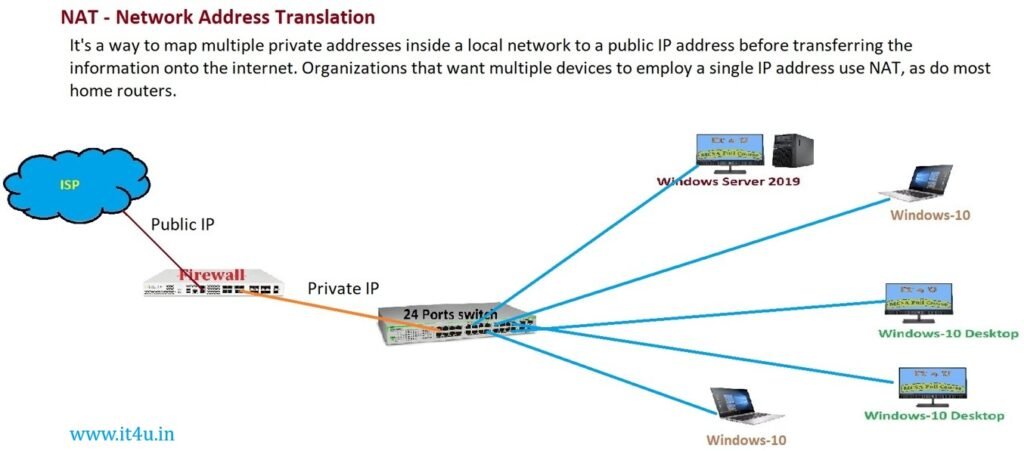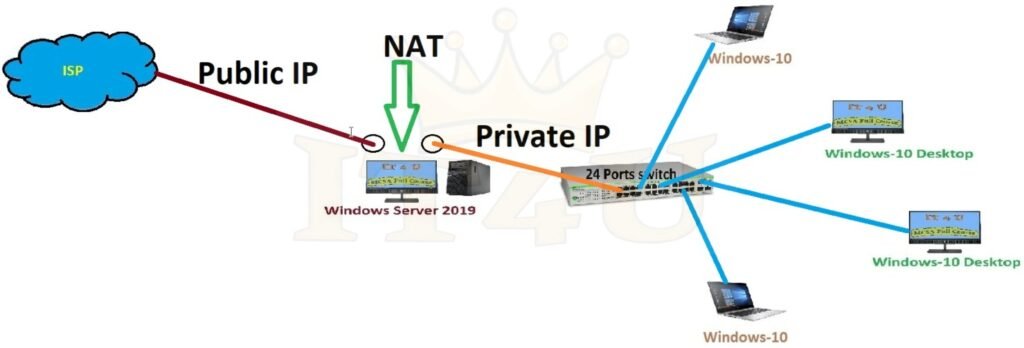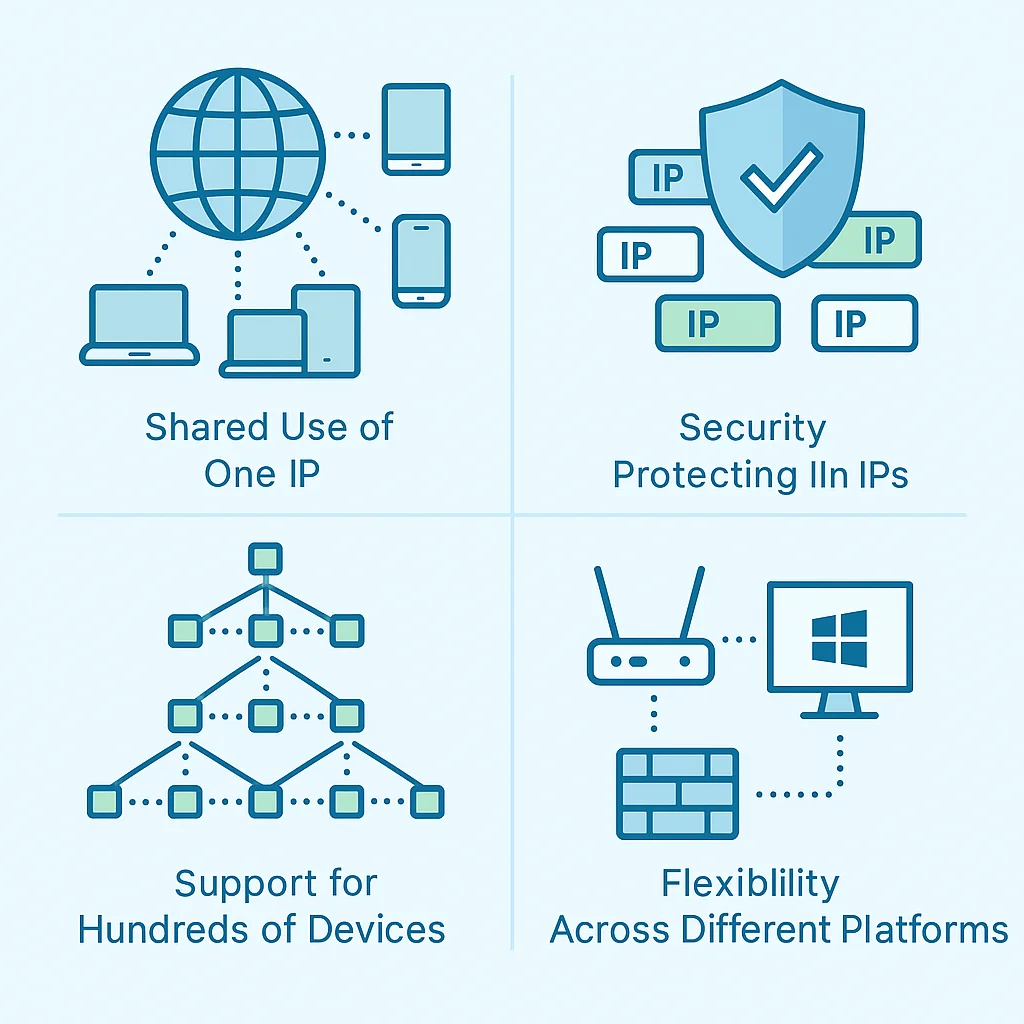Network Address Translation (NAT) in Windows Server
Introduction
In today’s digital world, the demand for internet-connected devices has exploded. Every home and office has multiple laptops, smartphones, smart TVs, and IoT devices—all needing internet access. If every device required a unique public IP address, we would have run out of IPv4 addresses long ago.
This is where Network Address Translation (NAT) comes in. NAT allows multiple private IP addresses inside a local network to access the internet through a single public IP. It not only saves IP addresses but also adds a layer of security by masking internal systems.
In this blog, part of the MCSA Server 2019 Full Course, we will explore what NAT is, why it’s important, and how to configure NAT on Windows Server.
What is Network Address Translation (NAT)?
Network Address Translation (NAT) is a networking technique that translates private IP addresses into a public IP when accessing the internet and vice versa when receiving responses.

This ensures that devices within a private network remain hidden from the outside world while still being able to communicate with external servers.
Example:
- Your ISP provides one public IP to your router.
- NAT translates this into multiple private IPs for your laptop, phone, and smart TV.
- All devices access the internet through the single public IP assigned by the ISP.
Why Do We Need NAT?
- Prevent IP Shortage
Originally, ISPs gave every device a separate public IP. With millions of devices in use today, this system quickly became unsustainable. NAT solves this by letting many devices share a single public IP. - Efficient Address Management
NAT uses private IP ranges reserved by IANA:- Class A: 10.0.0.0 – 10.255.255.255
- Class B: 172.16.0.0 – 172.31.255.255
- Class C: 192.168.0.0 – 192.168.255.255
- Security Advantage
NAT hides internal IP addresses from the public internet. This makes it harder for attackers to directly target devices inside your network.
NAT in Real-World Scenarios
Home Networks

- ISP assigns one public IP to your home router.
- NAT converts it into private IPs for multiple connected devices.
- Example: Laptop (192.168.1.10), Phone (192.168.1.11), Smart TV (192.168.1.12).
Enterprise Networks

- The public IP is configured on a firewall or router.
- NAT translates this IP into private addresses for hundreds of computers via switches.
- If no firewall or router exists, NAT can be configured on Windows Server with two NICs.
Configuring NAT in Windows Server

Follow these steps to configure NAT on a Windows Server:
Step 1: Add Two Network Adapters
- One NIC for Public IP (connected to ISP).
- One NIC for Private IP (connected to LAN).
Step 2: Install the Remote Access Role
- Open Server Manager → Add Roles and Features.
- Select Remote Access.
- Enable Routing and NAT features.
Step 3: Configure Routing and Remote Access
- Go to Tools → Routing and Remote Access.
- Right-click the server → Configure and Enable.
- Choose Network Address Translation (NAT).
- Assign the public interface.
Step 4: Configure DNS
- Use internal DNS if available.
- Otherwise, set external DNS (e.g., Google 8.8.8.8).
Step 5: Test Internet Connectivity
- Assign private IPs to client systems.
- Set the NAT server’s private IP as the default gateway.
- Test using
ping google.com.
If NAT is properly configured, all devices will connect to the internet via the server.
Benefits of NAT

- Saves Public IPs – Multiple devices share one IP.
- Improves Security – Internal IPs stay hidden.
- Scalability – Supports hundreds of devices in enterprises.
- Flexibility – Works on routers, firewalls, or Windows Server.
Conclusion
NAT is an essential concept for both IT professionals and beginners. It prevents IP wastage, improves security, and ensures that modern networks can handle the growing number of devices.
For MCSA students, knowing how to configure NAT on Windows Server is both a practical skill and a common interview question.
💡 What do you think about NAT? Have you configured it in your home or company network? Share your thoughts in the comments below!
👉 Don’t forget to subscribe to IT4U for more free tutorials on MCSA, CCNA, and Security.
Frequently Asked Questions (FAQ)
1. What is the main purpose of NAT?
NAT allows multiple private IP addresses to access the internet using a single public IP, preventing IP shortages.
2. What are the private IP ranges?
- 10.0.0.0/8
- 172.16.0.0/12
- 192.168.0.0/16
3. Can NAT be configured without a router?
Yes. NAT can be configured on Windows Server using two NICs (one public, one private).
4. Does NAT improve security?
Yes. NAT hides internal private IPs from external networks, making direct attacks harder.
5. Is DNS required for NAT to work?
Yes. NAT translates addresses, but DNS is needed to resolve domain names like google.com.
6. Is NAT still relevant with IPv6?
With IPv6, address space is huge, so NAT is less critical. However, it remains widely used in IPv4 networks.
7. Is NAT important for the MCSA exam?
Yes. NAT configuration and its concepts are frequently asked in MCSA interviews and exams.
NAT (Network Address Translation) – Interview Questions and Answers
1. What is NAT, and why do we use it in networking?
NAT stands for Network Address Translation. It allows multiple devices in a private network to access the internet using a single public IP address. We use NAT mainly to conserve public IPv4 addresses and to add a layer of security by hiding internal IPs from the outside world.
2. What are the differences between public IP and private IP?
Public IP is assigned by the ISP and routable over the internet. Private IP is used only within local networks and is not routable on the internet. NAT connects the two by translating private IPs into a public one.
3. Can you explain the role of NAT in conserving IPv4 addresses?
IPv4 has a limited number of addresses. Without NAT, every device would need a unique public IP. NAT allows thousands of private devices to share one public IP, significantly reducing the consumption of IPv4 addresses.
4. Name the private IP ranges defined by IANA.
Class A: 10.0.0.0 – 10.255.255.255
Class B: 172.16.0.0 – 172.31.255.255
Class C: 192.168.0.0 – 192.168.255.255
5. How does NAT improve the security of a private network?
NAT hides internal private IPs from external networks. Attackers only see the public IP, making direct access to devices inside the network more difficult.
6. What are the different types of NAT (Static, Dynamic, PAT)?
Static NAT maps one private IP to one public IP. Dynamic NAT uses a pool of public IPs, assigned as needed. PAT (Port Address Translation) allows many private IPs to share a single public IP using different port numbers.
7. What is the difference between SNAT and DNAT?
SNAT (Source NAT) changes the source address of packets, usually when private devices connect to the internet. DNAT (Destination NAT) changes the destination address, often used to forward external traffic to an internal server.
8. Can you explain Port Address Translation (PAT) with an example?
PAT allows multiple private devices to use one public IP by assigning different port numbers. Example: Laptop → PublicIP:1001, Mobile → PublicIP:1002, Printer → PublicIP:1003. Ports keep each session unique.
9. How does NAT work in a home router compared to an enterprise firewall?
In home routers, NAT is preconfigured and automatic. In enterprises, NAT is more complex, managed by firewalls or servers with specific rules for subnets, VLANs, and security policies.
10. What issues can arise when using NAT in peer-to-peer applications?
NAT can block direct device-to-device connections. Applications like VoIP, online gaming, or video conferencing may face issues unless NAT Traversal or port forwarding is used.
11. In what scenarios would you configure NAT on a Windows Server instead of a router/firewall?
NAT is configured on a Windows Server when no dedicated router or firewall is available. For example, in a small office with only a server and ISP connection, the server can act as both a gateway and NAT device.
12. How does NAT impact end-to-end connectivity in IPv4 networks?
NAT breaks the true end-to-end connection because the source and destination IPs are altered. While this saves IPs, it can interfere with some applications that rely on fixed IP addresses.
13. What is NAT Traversal, and why is it important for VPNs?
NAT Traversal is a method that allows VPN traffic to pass through devices using NAT. Since NAT modifies packet headers, VPN protocols may fail. NAT Traversal solves this by encapsulating VPN traffic so it reaches the correct destination.
14. Can NAT be used with IPv6? Why or why not?
NAT is less necessary with IPv6 because the address space is extremely large. Each device can have a unique global address. However, NAT can still be used in IPv6 for specific cases like privacy or internal policies, but it is not as common as in IPv4.
15. How would you troubleshoot if NAT is configured, but internal clients cannot access the internet?
1. Check if the server/router has a valid public IP.
2. Ensure the NAT rule is correctly applied to the public interface.
3. Verify DNS settings on internal clients.
4. Ping external IPs (e.g., 8.8.8.8) to confirm connectivity.
5. Check firewall policies that might block NAT traffic.









Add comment